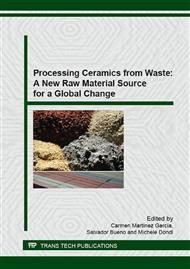[1]
S. Alonso, A. Palomo, Alkaline activation of metakaolin and calcium hydroxide mixtures: influence of temperature, activator concentration and solids ratio, Mat. Lett. 47 (2001) 55– 62.
DOI: 10.1016/s0167-577x(00)00212-3
Google Scholar
[2]
J. Cabrera, M.F. Rojas, Mechanism of hydration of the metakaolin–lime–water system, Cem. Concr. Res. 31 (2001) 177–182.
DOI: 10.1016/s0008-8846(00)00456-7
Google Scholar
[3]
M. Frias, J. Cabrera, Influence of MK on the reaction kinetics in MK/lime and MK-blended cement systems at 20 ºC, Cem. Concr. Res. 31 (2001) 519– 527.
DOI: 10.1016/s0008-8846(00)00465-8
Google Scholar
[4]
W.K.W. Lee, J.S.J. Van Deventer, The effect of ionic contaminants on the early-age properties of alkali-activated fly ash-based concretes, Cem. Concr. Res. 32(4) (2002) 577-584.
DOI: 10.1016/s0008-8846(01)00724-4
Google Scholar
[5]
J. Temuujin, A. Van Riessen, R. Williams, Influence of calcium compounds on the mechanical properties of fly ash geopolymer pastes, J. Hazard. Mater. 167(1-3) (2009) 82-88.
DOI: 10.1016/j.jhazmat.2008.12.121
Google Scholar
[6]
F. Puertas, M. Palacios, Effect of shrinkage-reducing admixtures on the properties of alkali-activated slag mortars and pastes, Cem. Concr. Res. 37(5) (2007) 691–702.
DOI: 10.1016/j.cemconres.2006.11.021
Google Scholar
[7]
A. Fernández-Jiménez, J.G. Palomo, F. Puertas, Alkali-activated slag mortars: Mechanical strength behaviour, Cem. Concr. Res. 29(8) (1999) 1313-1321.
DOI: 10.1016/s0008-8846(99)00154-4
Google Scholar
[8]
J.J. Chang, W. Yeih, C.C. Hung, Effects of gypsum and phosphoric acid on the properties of sodium silicate-based slag pastes, Cem. Concr. Compos. 27(1) (2005) 85–91.
DOI: 10.1016/j.cemconcomp.2003.12.001
Google Scholar
[9]
I.G. Richardson, J.G. Cabrera, The nature of CSH in model slag-cements, Cem. Concr. Compos. 22 (2000) 259–266.
Google Scholar
[10]
P. Chindaprasirt, T. Chareerat, V. Sirivivatnanon, Workability and strength of coarse high calcium fly ash geopolymer, Cem. Concr. Compos. 29 (2007) 224–229.
DOI: 10.1016/j.cemconcomp.2006.11.002
Google Scholar
[11]
P. Chindaprasirt, C. Jaturapitakkul, W. Chalee, U. Rattanasak, Comparative study on the characteristics of fly ash and bottom ash geopolymers, Waste Manage. 29 (2009) 539-543.
DOI: 10.1016/j.wasman.2008.06.023
Google Scholar
[12]
J.G.S. Van Jaarsveld, J.S.J. Van Deventer, G.C. Lukey, The characterization of source materials in fly ash-based geopolymers, Chem. Eng. Commun. 191 (2003) 531-549.
DOI: 10.1016/s0167-577x(02)00971-0
Google Scholar
[13]
E.I. Diaz, E.N. Allouche, S. Ecklund, Factors affecting the suitability of fly ash as source material for geopolymers, Fuel 89 (2010) 992–996.
DOI: 10.1016/j.fuel.2009.09.012
Google Scholar
[14]
R.R. Lloyd, J.L. Provis, J.S.J. Van Deventer, J.S. J, Acid Resistance of Inorganic Polymer Binders. 1. Corrosion Rate, Mater. Struct. 45(1-2) (2012) 1-14.
DOI: 10.1617/s11527-011-9744-7
Google Scholar
[15]
ASTM D-3682-78. "Major and Minor Elements in Coal and Coke Ash by atomic Absorption.
Google Scholar
[16]
F.H. Chung, Quantitative interpretation of x-ray diffraction patterns of mixture iii: simultaneous determination of a set of reference intensities, J. Appl. Crystalogr. 7 (1974) 17-19.
DOI: 10.1107/s0021889875009454
Google Scholar
[17]
F.H. Chung, Quantitative interpretation of x-ray diffraction patterns of mixture i and ii: matrix flushing method for quantitative multicomponent analysis, J Appl Crystalogr 7 (1974) 519-531.
DOI: 10.1107/s0021889874010375
Google Scholar
[18]
P.H. Klug E.L. Alexander, X-ray diffraction procedures for polycrystalline and amorphous materials (1974) 2nd Edition.
Google Scholar
[19]
Y. Luna, C. Fernández Pereira, J. Vale, Waste Stabilization/Solidification (S/S) of Eaf Dust Using Fly Ash-Based Geopolymers. Influence of Carbonation on the Stabilized Solids, Coal. Combust. Gasification. Products. 2 (2010) 1-8.
DOI: 10.4177/ccgp-d-09-00015.1
Google Scholar
[20]
ASTM (1991) E 761-86: Compressive strength of the fire-resistive material applied to structural member. ASTM International, USA.
Google Scholar
[21]
T. Cerulli, C. Pistolesi, C. Maltese, D. Salvioni, Durability of traditional plasters with respect to blast furnace slag-based plaster, Cem. Concr. Res. 33 (2003) 1375–1383.
DOI: 10.1016/s0008-8846(03)00072-3
Google Scholar
[22]
F. Puertas, S. Martinez-Ramirez, A. Alonso, T. Vasquez, Alkaliactivated fly ash/slag cements: strength behaviour and hydration products, Cem. Concr. Res. 30(10) (2000) 1625–1632.
DOI: 10.1016/s0008-8846(00)00298-2
Google Scholar
[23]
C.K. Yip, G.C. Lukey, J.S.J. Van Deventer, The coexistence of the geopolymeric gel and calcium silicate hydrate at the early stage of alkaline activation, Cem. Concr. Res. 35 (2005)1688-1697.
DOI: 10.1016/j.cemconres.2004.10.042
Google Scholar
[24]
P. Nath, P.K. Sarker, Geopolymer concrete for ambient curing condition. Departament of civil engineering. Curtin University (2010).
Google Scholar
[25]
K. Vijai, R. Kumutha, B.G. Vishnuram, Effect of types of curing on strength of geopolymer concrete. Int. J. Phys. Sci. 5(9) (2010) 1419-1423.
Google Scholar
[26]
D. Khale, R. Chaudhary, Mechanism of geopolymerization and factors influencing its development: a review, J. Mater. Sci. 42(3) (2007) 729-746.
DOI: 10.1007/s10853-006-0401-4
Google Scholar
[27]
P. Xincheng, Y. Changhui, L. Fan, Studies on resistance of alkali-activated slag concrete to acid attack, In: Proceedings of the 2nd International Conference on Alkaline Cements and Concretes. (1999) 717-722.
Google Scholar
[28]
A. Allahverdi, F. Škvára, Sulfuric acid attack on hardened paste of geopolymer cements. Part 1. Mechanism of corrosion at relatively high concentrations, Ceramics−Silikáty 49 (4) (2005) 225-229.
Google Scholar
[29]
Y. Luna Galiano. 2013. Study of stabilization/solidificationo of industrial wastes by means the technology of geopolymers based on fly ash from thermal power station. Ph.D. Thesis of University of Seville. Spain.
Google Scholar


